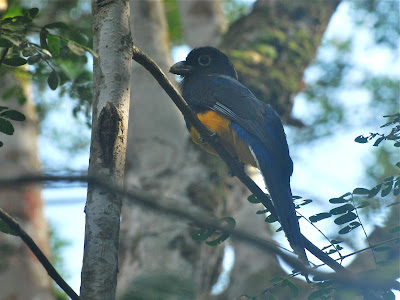Every time I go to Penonome (Cocle province, central Panama), I try to wander around, taking photos not only of birds, but of every interesting stuff I can find... however, this is a bird-photos post from Penonome. I traveled with Gloriela, Gabrielle and some relatives, starting around the "finca", in the outskirts of the town, where Gloriela's dad have a cabin surrounded by fruiting trees, including many papayas trees with mature fruits. It turned out to be a natural feeder for a big bunch of Red-legged Honeycreepers, including several males in alternate plumage (very colorful).
Around the cabin, a little creek surrounded by a not-so-tall gallery forest holds several pairs of Blue-crowned Motmots. I already posted a rationale about calling these birds Whooping Motmots... they have a distinctive voice; however, the AOU do not recognizes the split, neither the Panama Audubon Society.
We then visited a stretch of the mighty Zaratí river, in a place called Barrigon. The rapid-flowing river in this part is bordered by huge barrigon trees (Pseudobombax sp.), with some understore... a perfect habitat for this Cocoa Woodcreeper, despite we usually think on this bird as a forest inhabitant.
Back to our house, even the live fence have its own birds. The only antbird present in this part of town is the Barred Antshrike. This species exhibit a strong sexual dimorphism, the male is totally barred white and black, while the female (pictured here) is rufescent.
The White-tipped Dove is very common (but quite shy)... its voice is a familiar sound of the coclesian savanna... reminiscent of blowing through a bottle.
Well, it is always nice to wander around Penonome!































































